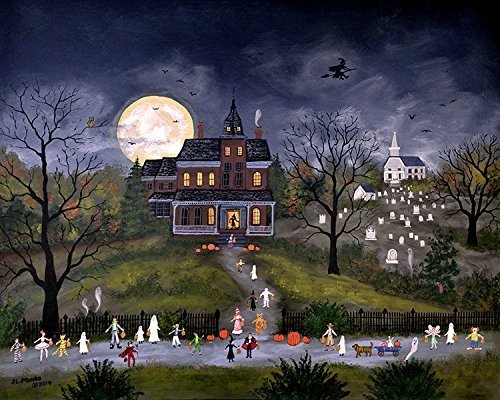by Michael Hofferber. Copyright © 1994 All rights reserved.
In the crisp chill of October night costumed children toddle down darkened lanes, their tittering voices fending off silence.
They come dressed as ghouls and monsters, aliens of outer space and starship captains from the 25th century. Masked as heroes and demons, wild animals and crazed villains, our youth knocks upon the doors of strangers demanding treats.
In Ireland, once upon a time, it was the adults who dressed up as imps and fairies on All Hallow's Eve, painting their faces and shrouding their bodies.
This was the year's end, the close of summer, and the spirits of all who died of late were said to wander the night looking for some person or animal to inhabit on their way to the afterlife. It was possession the spirits were after and possession the Celtic people wanted to avoid.
Households were darkened the night of October 31 and all fires inside extinguished. Then the residents, costumed as hideously as possible, charged the pitch black rooms yelling in mock anger and throwing the furnishings about. This would frighten any furtive spirits lurking within, driving them into the streets where they were paraded toward a bonfire at the edge of town.
The bonfire, set by a Druid priest, would scare off the last of the spirits and the residents then concluded the exercise with a harvest celebration.
Early Christians costumed themselves as well on the eve of All Saint's (or Hallows) Day, better known as Halloween. Some would dress themselves up as patron saints for the feasting and celebration.
Two days later, on All Soul's Day, some Christians took to the streets to go "souling." This was in medieval Europe, mind you, and the villagers went door to door asking for "soul-cakes" -- squarish biscuits flavored with currants. The more cakes you gave them the more prayers they would offer up to heaven for your dead relatives. They chanted as they paraded:
Soul! soul! for a soul-cake;
Pray good mistres, for a soul-cake.
One for Peter, two for Paul,
Three for them that made us all.
Prayers for the dead were considered quite valuable back then because they helped speed a soul's passage through limbo and into heaven. The more prayers they received the shorter the journey.
Halloween came to America following the potato famines in Ireland during the 1840s. Irish immigrants settled in New England by droves, traditional holidays and customs packed tightly in their bags. But by the turn of the century October 31 had evolved into Mischief Night for young American boys who ran through the dark tipping over outhouses, slapping people with bags of flour, hoisting vehicles to rooftops and leaving a trail of litter and unhinged gates in their wake..
"Trick or Treat," the little ones now cry, offering no prayers for the dead or ghostbusting for the household. Nor are they blackmailing us with threats of egg-stained siding and toilet-papered shrubbery. Instead they come to us costumed in the faith that on this one holy night candies are free for the asking.


